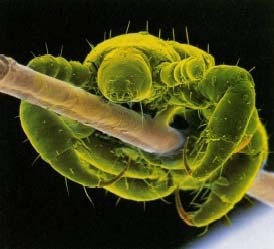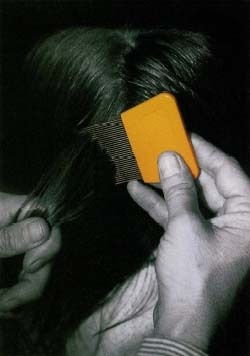Lice
Lice are tiny insects that can be found on the scalp, body, pubic area, or clothing and whose bites may lead to severe itching.
KEYWORDS
for searching the Internet and other reference sources
Parasites
Pediculosis
Sexually transmitted diseases
A Lousy Deal
Lice are tiny insects that are found on the hairy parts of the body or in clothing. A single one of these insects is known as a louse, and the eggs of a louse are known as nits. The bites of these insects can cause severe itching. Judging from the way people talk, lice are not too popular. When people have an awful day, they say it was lousy. When they make a mess of things, they say they have loused up. When they are overly critical, they are said to be nit-picking.
* parasites are organisms that live on other organisms and usually cause harm or disease.
What Are Lice?
The medical term for having lice is pediculosis (pe-dik-yoo-LO-sis). Lice are parasites * (PAIR-a-sites) that feed on human blood. There are three types of lice that live on humans:
- Head lice (Pediculus humanus capitus). These lice are usually found on the scalp.
- Body lice (Pediculus humanus corporis). These lice are found in clothing, from which they travel to the skin to feed.
- Pubic (PYOO-bik) lice (Phthirus pubis). These lice, also known as crab lice, are found in the pubic area, surrounding the genitals.

Who Gets Lice, and How?
Lice are a very common problem. Anyone can get lice, which are easily spread from person to person. Head lice are spread by close contact with a person who already has them. They also can be passed by sharing combs, brushes, hats, barrettes, pillows, headphones, and the like. Head lice are especially common in young children and their families. They may spread quickly among children in school or camp. They are not a sign of dirtiness or poor hygiene.
Body lice usually are passed along on clothing and bedding. They are sometimes found in people who live in crowded conditions where clothes are not changed or washed very often. Pubic lice usually are spread by close physical contact involving the genital area, such as sexual contact, so typically they are found in people who are sexually active. In a few cases, they may be picked up from bedding or clothing.
What Are the Symptoms?
Head lice do not cause serious medical problems. However, they can be very annoying. The first sign of trouble usually is severe itching on the part of the body where the lice ara biting. However, it may take as long as 2 or 3 weeks for the itching to start. Although it may be hard, a person with lice should try not to scratch, because this can spread the lice to other parts of the body. It also can lead to infection if germs are allowed to get into sores caused by scratching. Another possible sign of lice is a tickling feeling of something moving in the hair.
Although lice are tiny, they can be seen with the naked eye if a person looks closely. The nits, or eggs, are tiny yellow or white ovals attached to the hair near the scalp. They can be confused with dandruff or drops of hair spray. Nits take about a week to hatch into baby lice, known as nymphs. These babies turn into adults in another 7 days or so. Adult lice have six legs and are about the size of a sesame seed. They can live for up to 30 days on a person.
Head lice usually are found on the scalp. Often they are seen at the back of the neck and around the ears. In a few cases, head lice are found on the eyelashes or eyebrows. Body lice are hard to see on the body, because they burrow into the skin. They are usually easiest to see in the seams of clothing, from which they travel to the skin to feed. Pubic lice are found on the skin and hair of the pubic area. This is the area where hair grows around the genitals.
How Are Lice Treated?
Lice usually can be identified by sight. If the lice themselves are not seen, finding nits close to the scalp shows that a person has lice. The treatment for lice involves using a shampoo, cream rinse, or lotion that contains a medicine that kills lice. Such medicines are known as pediculicides (pe-DIK-yoo-li-sides). Some are sold over the counter, but others are sold only with a doctor's prescription. Home remedies that do not include a lice-killing medicine may not always work.
When using a lice-killing medicine, read the label and follow the instructions carefully. These medicines may be harmful if not used correctly and should be used with adult supervision, as follows:
- Remove all clothing before the treatment.
- Apply the product according to instructions.
- Do not use a regular cream rinse or combination shampoo-conditioner first.
- Do not wash the hair again for a couple of days.
- Put on clean clothing after the treatment.
Special combs are sold to help remove any leftover nits from the hair. The lice-killing medicine may need to be used again in 7 to 10 days to make sure that no nits have survived. If the treatment does not work, talk to a doctor. Do not use extra amounts of medicine or more treatments than suggested.

What Else Can Be Done?
These steps must be followed along with the use of lice-killing shampoos, rinses or creams to help prevent the spread of lice to others:
- Machine wash in hot water all clothing and bedding that the person with lice touched during the 2 days before treatment.
- Then put the clothes and bedding in a dryer on the hot cycle for at least 20 minutes.
- Dry clean any clothes that cannot be washed.
- Store any clothing, bedding, or stuffed animals that cannot be washed or dry cleaned in a sealed plastic bag for at least 2 weeks.
- Soak combs and brushes for about an hour in rubbing alcohol or Lysol, or wash them in soap and hot water.
- Vacuum the floors and furniture.
- Let the school know about the lice. Stay home until 24 hours after treatment, or as long as the school requires.
- Check other people who have had close contact with a person with lice for signs that they may have caught lice, too.
- In the case of a person with pubic lice, any sex partners from the month before treatment should be treated as well.
How Can Head Lice Be Prevented?
These steps can help prevent the spread of head lice:
- Never share combs and brushes.
- Always bring your own sleeping bag and pillow to a sleep-over.
- Do not try on a friend's hat or headphones.
- If your head itches, tell an adult right away; do not wait.
Resources
Fact Sheets
National Center for Infectious Diseases. "Head Lice
Infestation" and "Treating Head Lice." To order,
contact the Centers for Disease Control and Prevention, NCID, 1600
Clifton Road, N.E., Atlanta, GA 30333, (888) 232-3228.
http://www.cdc.gov/ncidod
National Institute of Allergy and Infectious Diseases. "Other
Important STDs." To order, contact the NIAID Office of
Communications and Public Liaison, 31 Center Drive, Building 31, Room
7A50, Bethesda, MD 20892-2520, (301) 496-5717.
http://www.niaid.nih.gov
Organization
National Pediculosis Association, P.O. Box 610189, Newton, MA 02461,
(781) 449-NITS. A group concerned with head lice.
http://www.headlice.org
Comment about this article, ask questions, or add new information about this topic: